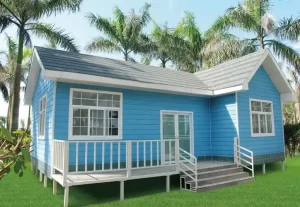As a unique form of construction in the field of architecture, prefabricated houses offer a number of significant advantages. These advantages make prefabricated houses an efficient, economical and practical building choice for specific scenarios and needs.

Fast construction and time saving
The main components of prefabricated houses are pre-produced in factories and then transported to the construction site for assembly. This production method greatly shortens the construction period of the building. Compared with the traditional on-site construction method, the construction speed of prefabricated houses can be several times faster or even more.
In some emergency situations, such as post-disaster reconstruction, temporary relocation, etc., the advantages of rapid construction of prefabricated houses are particularly prominent. It can provide a safe and comfortable living environment for the affected people in the shortest possible time and help them resume normal life as soon as possible. In addition, for some projects with tight schedules, prefabricated panel house is also an ideal choice to ensure that the project is completed on time and avoid economic losses due to delays.
Cost-effective
Lower material cost
The materials used for prefabricated houses are usually more affordable. For example, materials such as precast concrete panels and lightweight steel keels are relatively inexpensive and can be mass-produced to reduce costs. In addition, the design of prefabricated houses is usually more simple and does not require excessive decorative materials, further reducing material costs.
Low construction cost
Since most of the components of a prefabricated house are fabricated in a factory, the amount of work on the construction site is greatly reduced. This not only reduces labor costs, but also reduces the need for construction equipment, thus lowering construction costs. At the same time, the construction process of prefabricated houses is relatively simple and does not require complex techniques and technologies, which also reduces construction difficulties and risks.
Low maintenance cost
The structure of prefabricated houses is relatively simple and easy to maintain. Its materials usually have better durability and corrosion resistance, which can reduce the frequency of repair and replacement. In addition, the design of prefabricated panel houses usually takes into account energy-saving and environmental protection factors, such as good thermal insulation performance and solar energy utilization, which can reduce energy consumption and operating costs.
Reliable quality

Manufacturing plant site visits
Factory production guarantees quality
The components of prefabricated houses are made in factories with standardized production process and strict quality control system. The production environment in the factory is relatively stable and not affected by external factors such as weather, which can ensure the stable and reliable quality of the components. At the same time, factory production can also use advanced production equipment and technology to improve the precision and quality of the components.
Structural Stability
The structure of prefabricated houses is usually carefully designed and calculated to have good stability and anti-seismic performance. Materials such as precast concrete panels and light steel keel are strong and lightweight, and can withstand large loads and external forces. In addition, the connection of prefabricated houses usually adopts reliable bolting or welding, which ensures the integrity and stability of the structure.
Strong Flexibility
Flexible design
Prefabricated panel house can be personalized according to different needs. Whether it is the shape of appearance, internal layout or functional configuration, it can be customized according to customers' requirements. At the same time, the design of prefabricated panel house can also take into account the future expansion and remodeling needs, providing users with more choices and possibilities.
Flexible installation
The components of prefabricated houses can be flexibly assembled and disassembled at the construction site. This allows prefabricated buildings to be adapted and changed according to different site conditions and usage requirements. For example, it can be assembled and disassembled at different locations to realize repeated use; it can also be expanded or remodeled as needed to meet the changing needs of users.
Environmental protection and energy saving
Environmentally friendly materials
The materials used in precast panel houses usually have better environmental performance. For example, precast concrete panels can be used as raw materials, such as industrial waste as raw materials, reducing the consumption of natural resources; light steel keel and other materials can be recycled and reused, reducing the generation of construction waste. In addition, the design of prefabricated houses usually takes into account energy-saving factors, such as good thermal insulation, solar energy utilization, etc., which can reduce energy consumption and the impact on the environment.
Environmentally friendly construction
The construction process of prefabricated panel house is relatively simple and generates less construction waste. At the same time, the noise and dust pollution at the construction site is also relatively low, which has less impact on the surrounding environment. In addition, the construction process of prefabricated panel house can use green construction technology, such as assembly construction, the use of energy-saving environmental protection equipment, etc., to further improve the environmental performance of construction.
Wide range of applications
Prefabricated panel house can be used in a variety of scenarios, such as temporary housing, office space, warehouses, commercial facilities and so on. In some remote areas, construction sites, disaster areas and other places, prefabricated panel house can be used as a fast and economical solution to meet people's basic living and working needs. In addition, prefabricated panel house can also be used as a permanent form of construction for rural self-built houses, villas and other projects.
In conclusion, prefabricated panel house has many advantages such as rapid construction, cost-effective, reliable quality, flexibility, environmental protection and energy saving. In today's society, as people's requirements for building efficiency, quality and environmental performance continue to improve, prefabricated panel house, as an innovative form of construction, will be more and more widely used and developed.
Contact us:uwantvlink@gmail.com
Post time: 11-04-2024







